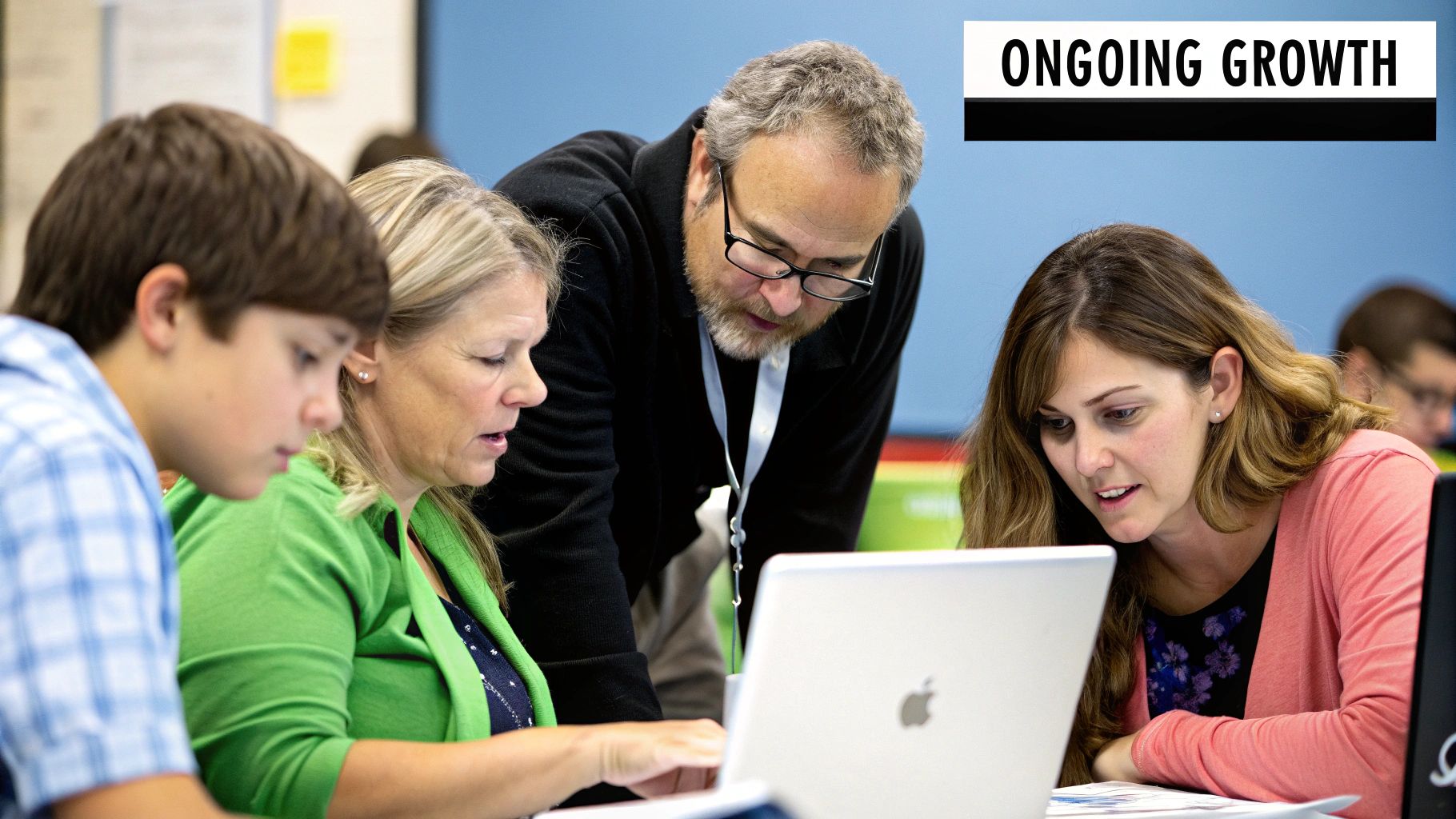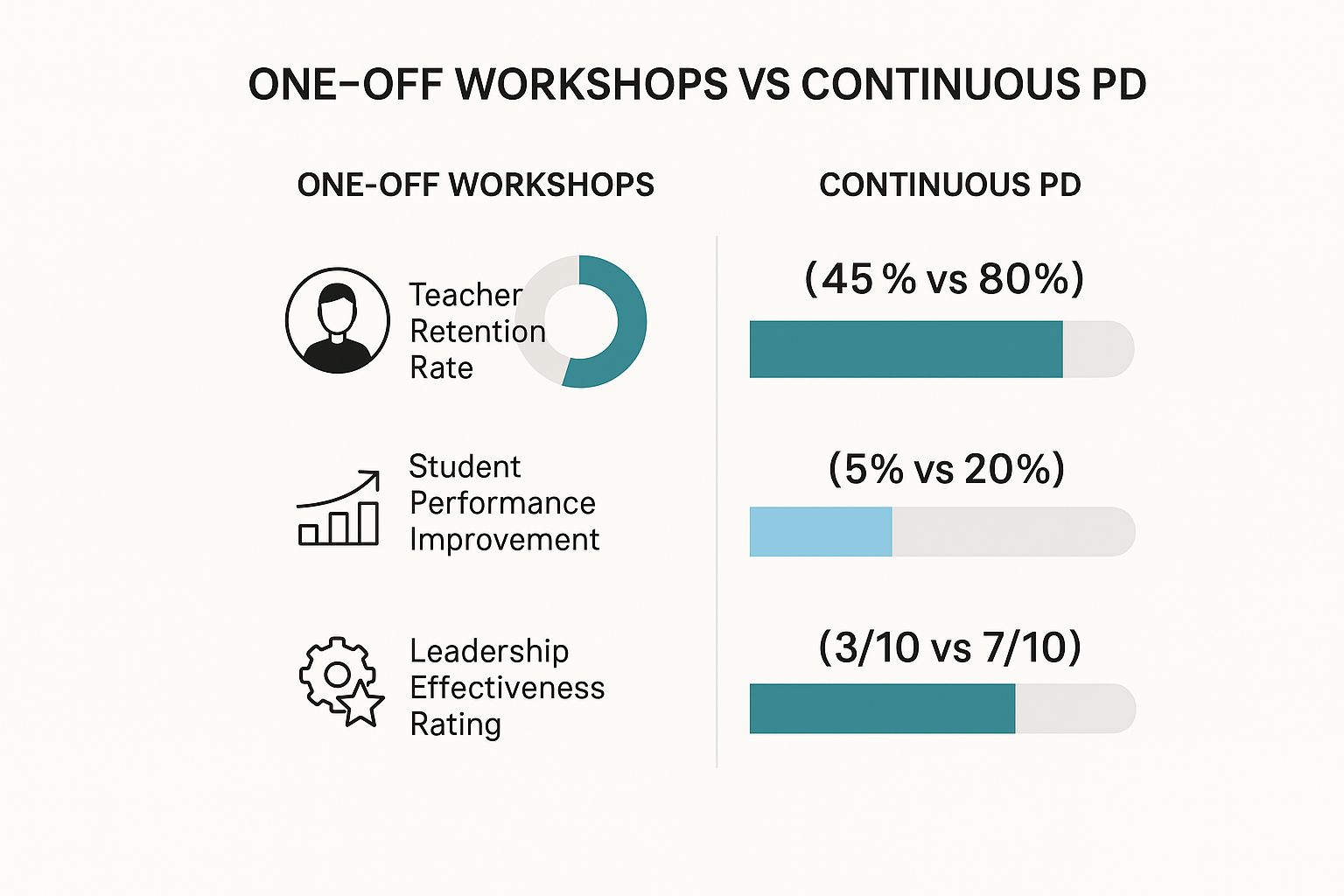
Enhance Your Career with Professional Development for Educators
Share
Let's be honest, professional development for educators used to mean isolated training days. Remember those? A one-off session that felt disconnected from the daily reality of the classroom. But things have changed. Now, we see it for what it truly is: a continuous journey of growth, deeply woven into the very fabric of a school's culture.
This modern approach is all about sustained learning, mentorship, and collaboration, tackling the real-world challenges we all face head-on.
Rethinking Professional Development for Today’s Educators

The old model of professional development was often a single workshop. You’d spend a day learning a new technique, full of inspiration, only for the momentum to fizzle out once you were back in the classroom whirlwind. Today, the most effective professional development for educators is built as an ongoing, dynamic process.
Think of it as the difference between a single sprint and training for a marathon. A sprint is a short, intense burst, but marathon training builds strength, endurance, and resilience over the long haul. In the same way, continuous professional development builds deep, lasting competence in our teaching staff.
This shift in perspective is absolutely crucial. It takes learning from being a passive event to an active, collaborative experience that directly boosts teaching quality, leadership, and, most importantly, student success. The focus is firmly on practical application, not just dusty theory.
Embracing a Culture of Continuous Growth
At its heart, this new approach is about creating a school-wide culture where learning never stops and is always shared. It’s a definite move away from top-down directives and towards a real community of practice where we all learn with and from each other.
This kind of collaborative environment lets teachers share challenges, brainstorm solutions, and celebrate successes together. It fosters a powerful sense of collective responsibility for our students and our own improvement. When you feel supported by your peers and leaders, you're far more likely to try out new strategies and really hone your craft.
Key elements of this culture include:
- Mentorship: Pairing seasoned educators with those newer to the profession to offer guidance and a helping hand. A practical example would be a weekly check-in where a mentor observes a lesson and provides constructive, supportive feedback on a specific teaching goal, like classroom transitions.
- Collaborative Learning: Carving out dedicated time for teachers to plan lessons, dig into student work, and share what’s working. For instance, a Year 4 team might meet fortnightly to analyse recent maths assessments and co-plan the next unit to address common misconceptions.
- Evidence-Based Practices: Grounding every development activity in solid research to ensure it makes a real difference in the classroom.
The goal is to build a self-improving system where professional growth isn't an 'extra' but a fundamental part of our daily work. This leads to more confident teachers and, in turn, more engaged learners.
Aligning with National Frameworks and Future Trends
In England, this structured approach is getting a big push from national frameworks. In fact, recent figures show that 88.4% of schools have had staff engage with the reformed National Professional Qualifications (NPQs) since 2021. That’s a huge commitment to structured career progression.
This level of systemic support really highlights how important it is to equip educators with the right skills. To stay ahead of the curve, we can also draw inspiration from innovative education events like Learntec 2023, which offer a glimpse into the future of digital learning and pedagogy.
By mixing structured national programmes with forward-thinking ideas, schools can build a development culture that is both robust and responsive to the evolving needs of students—including the critical area of mental health and wellbeing.
The Building Blocks of Impactful Teacher Development
So, what’s the real difference between professional development that sparks genuine change and a training day that’s forgotten by Friday? It isn’t about flashy presentations or grand gestures. It’s about getting the fundamentals right—the essential components that build a strong foundation for lasting improvement in the classroom.
Think of it like this: a one-off workshop is a bit like a single sprint. It's a short, intense burst of energy that quickly fades. A well-designed, continuous programme, however, is like training for a marathon. It builds strength, resilience, and deep-seated skills over the long haul. Time and time again, this embedded, long-term approach wins out over isolated sessions.
This infographic paints a clear picture of just how different the outcomes are between those short-term workshops and sustained professional development.

The data is undeniable. Continuous professional development leads to significant gains in teacher retention, pupil performance, and leadership effectiveness. These aren't just minor tweaks; they represent a fundamental shift in a school's ability to thrive.
To better understand this shift, let's compare the old way of thinking with the more effective, modern approach that is shaping teacher development today.
Comparing Traditional vs Modern Professional Development
This table highlights the key differences between the outdated, one-off training model and the principles of modern, continuous professional development, such as those found in the ECF and NPQ frameworks.
| Feature | Traditional Model (e.g. One-Day Course) | Modern Model (e.g. ECF/NPQ Framework) |
|---|---|---|
| Duration & Frequency | Isolated, single-day event. | Ongoing, spanning months or years. |
| Learning Style | Passive (listening to a speaker). | Active (practice, feedback, collaboration). |
| Support System | Little to no follow-up. | Embedded coaching and peer mentoring. |
| Relevance to Classroom | Often generic and theoretical. | Directly linked to real classroom challenges. |
| Teacher Role | Recipient of information. | Active participant and owner of their learning. |
| Goal | Information delivery. | Behavioural change and improved practice. |
| Impact on Pupil Outcomes | Minimal and difficult to measure. | Demonstrable and sustained improvement. |
As you can see, the modern approach is designed not just to inform but to transform. It’s a journey, not a destination, built on a few core principles.
Sustained Support and Active Learning
Truly effective professional development isn't delivered in a single dose. It’s an ongoing process that gives educators consistent support as they learn, experiment with new ideas, and tweak their practice over time. This could look like regular coaching sessions, mentoring from a seasoned colleague, or even just being part of a network of peers who are grappling with the same challenges.
And crucially, this process has to be built around active learning. Sitting passively in a lecture hall rarely changes what happens in a classroom on a Monday morning. Instead, teachers need to get their hands dirty and engage directly with new concepts. This means creating opportunities to:
- Observe master teachers in action and break down their techniques.
- Practise new strategies in a supportive, low-stakes setting.
- Receive constructive, thoughtful feedback from coaches or peers.
- Collaborate with colleagues to solve real-world problems from their own classrooms.
This active approach makes sure that the learning feels relevant, practical, and immediately useful. It shifts professional development from being something that is done to teachers into a process they can actively shape and feel a sense of ownership over.
Effective professional development provides teachers with adequate time and other resources to master new content, practice new skills, and integrate them into their classroom practice. It is an ongoing cycle of learning, application, and reflection.
The Power of Collaborative Learning
Collaboration is easily one of the most powerful building blocks of great professional development. When teachers are given the time and structure to learn from each other, they don’t just gain new skills—they build a more resilient and supportive school culture. Sharing struggles and brainstorming solutions together creates a powerful sense of shared purpose and a belief that, together, they can make a difference.
This collaborative spirit is absolutely vital for tackling complex issues like supporting pupil wellbeing. For educators today, understanding the basics of social-emotional skills is more important than ever. You can delve deeper by exploring what social and emotional learning is and how it can be woven into the fabric of daily school life. When staff build this shared knowledge base, they can develop a consistent, school-wide approach to nurturing emotional literacy in every child.
A huge part of impactful teacher development is also learning how to create engaging training materials that genuinely connect with learners, whether they're pupils or fellow educators. This is a skill that is sharpened best through collaborative practice and honest feedback.
Feedback and Structured Reflection
Finally, learning simply can’t stick without reflection. The most impactful professional development programmes build in structured time for educators to stop and think critically about their own practice. Meaningful feedback—whether it comes from a coach, a peer, or even through self-assessment—is the spark that ignites this deep reflection.
This simple addition turns learning from a passive experience into a dynamic cycle of continuous improvement. By regularly reflecting on what worked, what didn't, and why, teachers can make deliberate and thoughtful adjustments to their craft. This plan, do, study, act cycle is what drives real, long-term growth and ensures that professional development ultimately leads to better outcomes for every single pupil.
Getting to Grips with the ECF and NPQ National Frameworks

Here in England, professional development for teachers is becoming more and more structured around two key national programmes: the Early Career Framework (ECF) and National Professional Qualifications (NPQs). Far from being just tick-box exercises, they represent a serious, evidence-backed commitment to supporting teachers at every point in their career, from their very first day in the classroom right up to executive leadership.
This structured support is a direct answer to some long-standing challenges in the teaching workforce. To tackle this, the Department for Education has put aside around £700 million for recruitment and retention. The goal is to build more sustainable teaching careers by improving support for new teachers and creating clear paths for progression—and the ECF and NPQs are the cornerstones of this strategy. You can find out more about the government's approach to the teacher workforce and the funding behind it.
For any educator looking to map out their professional journey, understanding how these frameworks operate is absolutely essential.
The Early Career Framework: A Foundation for Success
The Early Career Framework (ECF) is so much more than a simple checklist for new teachers. It’s a full-on, two-year induction programme designed to build the confidence and skills of early career teachers (ECTs) right from the start. It replaced the old one-year model, recognising that it takes time to really find your feet in such a demanding profession.
At its heart, the ECF provides a structured curriculum of learning that’s grounded in solid evidence of what actually works in the classroom. This is all delivered through a powerful partnership model.
- Dedicated Mentorship: Every ECT gets paired with an experienced mentor for regular, one-to-one coaching. This relationship is vital for turning theory into effective classroom practice.
- Structured Support: The framework guarantees ECTs a reduced timetable in both their first and second years, giving them protected time for their own development.
- Evidence-Based Learning: The content covers the essentials like behaviour management, pedagogy, curriculum design, and assessment, all backed by proper research.
This isn't about piling more work onto a new teacher. It’s about providing a supportive scaffold, making sure that those newest to the profession have the tools, time, and guidance they need to not just survive, but truly thrive.
The ECF is a fundamental promise to new teachers: you will be supported, you will be developed, and you will be given the best possible start to your career. It is a direct investment in teacher quality and, crucially, in teacher retention.
National Professional Qualifications: A Ladder for Leaders
Once a teacher is more established, the National Professional Qualifications (NPQs) offer clear, structured routes for career progression. These qualifications are for teachers and leaders who want to develop their expertise in specific areas or move into leadership roles. Think of them as a ladder, where each rung is a step up in responsibility and expertise.
And NPQs aren't just for aspiring headteachers anymore. The whole framework has been updated and expanded to offer a much wider range of specialisms, reflecting the diverse leadership roles that exist in a modern school.
This updated suite of qualifications includes:
- Specialist NPQs: These are perfect for teachers who want to deepen their knowledge in a specific area without leaving the classroom behind. Options include leading teacher development, leading literacy, and leading behaviour and culture.
- Leadership NPQs: These are for those aiming for formal leadership roles, from senior leadership and headship right up to executive and trust-level leadership.
Each NPQ is a blend of independent study, face-to-face sessions, and practical application within your own school. This makes sure the learning is directly relevant to what you do day-to-day. By creating these clear and well-regarded qualifications, the NPQ framework helps build a strong pipeline of skilled and effective school leaders, ensuring the profession continues to develop excellence from within.
Why Mental Health Training Is Now Non-Negotiable
In today's classrooms, looking after pupils’ mental health isn't just a helpful extra anymore—it’s become a core part of our responsibility as educators. The world our children are growing up in has changed, and their emotional needs have changed right along with it. Addressing mental health openly and proactively is vital, as it builds a foundation for academic learning, social skills, and future success.
This shift means that dedicated mental health training has to be an essential part of any professional development programme for teachers.
The numbers really bring this home. It's estimated that one in six children between the ages of 7 and 16 now has a probable mental health problem. That’s not some distant statistic; it represents real children in our classrooms, every single day, trying to navigate feelings they might not even have the words for.
As educators, we're on the front line of this quiet crisis. We are in a unique position to spot the early warning signs and create a classroom where children feel safe enough to ask for help. It’s not about turning us into therapists, but about giving us the basic skills to offer compassionate, first-level support.
The Rising Tide of Childhood Mental Health Issues
The pressures on young people today are immense. From academic expectations and tricky social dynamics to stresses at home, it all adds up. And then there's the undeniable impact of social media, which has completely reshaped how children see themselves and connect with the world.
The online world can be great for connection, but it's also a place of constant comparison and filtered perfection. The pressure to present a flawless life can significantly amplify feelings of anxiety, low self-worth, and loneliness, creating a disconnect between a child’s online persona and their real-life feelings. For us, understanding this bigger picture is vital if we want to truly support the children in our care.
The cost of not acting is huge, not just for the children themselves but for society. Poor mental health in childhood can cast a long shadow, affecting everything from exam results to future job prospects. In fact, Deloitte estimates that poor mental health costs UK employers up to £56 billion a year in absenteeism, presenteeism and staff turnover. Investing in early support isn't just the right thing to do; it makes social and economic sense, too.
Equipping Educators with Practical Skills
Good mental health training isn’t about theory; it’s about providing practical, actionable skills that teachers can use straight away. It’s about building the confidence to spot a pupil who might be struggling and knowing how to start a supportive conversation.
This kind of professional development should cover key areas like:
- Recognising Early Signs: Learning to spot those subtle changes in a child’s behaviour, mood, or engagement that might hint at an underlying issue. For example, a normally outgoing child becoming withdrawn, or a pupil suddenly struggling to concentrate.
- Creating a Supportive Atmosphere: Building a classroom culture where pupils feel safe to talk about their feelings without being judged. This could involve daily emotional check-ins where students can indicate how they're feeling using colours or symbols.
- Active Listening: Developing the skill of listening with empathy to validate a child's experience, making them feel truly heard and understood. This means putting down your pen, making eye contact, and reflecting back what you hear, such as saying, "It sounds like you felt really lonely when that happened."
- Signposting to Support: Knowing the clear steps for referring a child to school counsellors, pastoral leads, or external agencies when they need more specialised help.
It’s crucial to remember that our role is to be the first point of contact, not the final diagnosis. Our responsibility is to notice, support, and signpost.
Prioritising Self-Care and Wellbeing
To support others well, we have to look after our own mental health first. Teaching is an emotionally demanding job, and burnout is a very real risk. That's why professional development should also include strategies for our own wellbeing.
Simple relaxation tips can make a huge difference in managing the day-to-day stress:
- Mindful Breathing: Just take a few moments between lessons to focus on slow, deep breaths. It’s a quick way to calm your nervous system and refocus. Try the 'box breathing' technique: inhale for four seconds, hold for four, exhale for four, and hold for four.
- Digital Detox: Set clear boundaries around checking work emails outside of school hours. Your personal time is precious. A practical tip is to remove email notifications from your phone.
- Connect with Colleagues: Sharing what you’re going through with your peers can make you feel less isolated and builds a vital support network. Even a quick chat in the staffroom can make a world of difference.
When we model self-care, we also teach our pupils a valuable life lesson about looking after their own wellbeing.
Normalising the Conversation
We can also help break down the stigma around mental health through simple, everyday actions. Wearing mental health-themed apparel, like a t-shirt or lanyard with a positive message, can be a great conversation starter and signals to pupils that you're a safe person to talk to.
In the same way, bringing carefully chosen mental health books into the curriculum can open up discussions about emotions in a natural, accessible way. Stories like those from Little Fish Books provide a shared language for talking about feelings like anxiety or sadness and help build empathy across the whole classroom.
Disclaimer: While this section offers guidance, I am not a mental health professional. The information provided is for educational purposes only and should not replace professional medical advice. If you are worried about your own mental health or that of a child, please consult a doctor or a qualified mental health practitioner.
Practical Strategies for Supporting Pupil Wellbeing

Understanding why pupil mental health matters is one thing; actually fostering it in a busy classroom is another challenge altogether. This is where effective professional development for educators needs to bridge the gap, moving from theory to tangible, everyday practice. It’s all about equipping teachers with a toolkit of practical strategies they can weave seamlessly into the school day, not treat as yet another task on the to-do list.
The goal here is to create a classroom environment where emotional wellbeing is just as fundamental as literacy or numeracy. By integrating small, consistent practices, we can build a culture that nurtures resilience, empathy, and emotional awareness in every single child.
These strategies don't need huge budgets or complicated plans. Instead, they’re about being intentional with your space, your language, and your time to show pupils that their feelings are valid, important, and manageable.
Creating a Mentally Healthy Classroom
A classroom that truly supports wellbeing is one where children feel safe, both physically and emotionally. It's a space where they feel understood and have the freedom to regulate their emotions. One of the most effective ways to make this happen is by setting up dedicated spaces for emotional regulation.
A 'calm-down corner' or 'peace corner' is a perfect example. This isn't a time-out spot for punishment; it’s a sanctuary where a child feeling overwhelmed can go to self-soothe.
- Stock it with sensory items: Think soft cushions, a weighted lap pad, stress balls, or fiddle toys.
- Add visual aids: Emotions charts or posters with simple breathing exercises can give children a helpful guide.
- Set clear expectations: Teach pupils that this space is for everyone to use whenever they need a moment to reset their feelings. A practical example is using a sand timer to ensure the space is shared fairly.
This simple addition sends a powerful message: it’s okay to feel big emotions, and more importantly, there are healthy ways to cope with them. It’s a proactive strategy that empowers children to start managing their own emotional state.
Creating these safe spaces is a key part of what schools can do to provide emotional support. By nurturing student wellbeing in this way, we teach children vital self-regulation skills they will carry with them for life.
Integrating Wellbeing into Daily Routines
The wellbeing strategies that stick are the ones that become part of the classroom’s natural rhythm. When you integrate them into daily routines, they become consistent and accessible to all pupils, rather than being reserved for moments of crisis.
Circle time, for instance, offers a fantastic opportunity to build emotional vocabulary. A practical example is a 'feelings register' where, instead of just saying "here", each child names an emotion they are feeling that morning. This simple act normalises conversations about emotions and helps children find the words to express themselves clearly.
Likewise, starting the day with a short mindfulness exercise can have a profound impact. Even just one minute of guided breathing can help settle a restless class and sharpen focus. Simple techniques like 'hot chocolate breathing' (pretending to breathe in the smell of hot chocolate and then cool it down with a long breath out) are easy enough for even the youngest children to follow.
These small, repeated actions build a strong foundation of emotional literacy.
Using Resources to Spark Conversation
Sometimes, just starting a conversation about feelings is the hardest part. This is where high-quality resources, like mental health books for children, become invaluable tools. A well-chosen story can act as a springboard, allowing children to explore complex emotions through characters and situations they can relate to.
The books from Little Fish Books are designed specifically for this. They provide a gentle, accessible way to open up discussions about topics like anxiety, sadness, and friendship. Reading a story together creates a shared experience and gives you a natural opening to ask questions like:
- "How do you think the character was feeling in this part of the story?"
- "Have you ever felt that way before?"
- "What helped the character feel better?"
These discussions build empathy and show children that they are not alone in what they're feeling. It’s a powerful method for embedding social-emotional learning directly into your existing literacy planning.
You can also normalise the conversation through simple visual cues. For example, wearing mental health-themed apparel with a positive message can signal to pupils that you are a safe and approachable adult to talk to. It’s a subtle but effective way to challenge stigma and create an open atmosphere. Remember, the goal of this professional development is to empower educators with concrete ideas to foster a culture of wellbeing in their school.
Disclaimer: This information is for educational purposes only. I am not a mental health professional. If you are worried about a child's mental health, please seek advice from your GP or a qualified professional.
Frequently Asked Questions
When it comes to professional development, it’s easy to get tangled up in questions. Whether you're a new teacher still finding your feet or a seasoned leader looking to galvanise your staff, getting clear, practical answers is a game-changer. This section tackles some of the most common queries we hear about building genuine professional growth in schools.
Our goal is to give you straightforward insights that you and your colleagues can actually use. From nurturing the right culture to managing impossible workloads, let's explore what really works.
How Can Schools Create a Culture of Continuous Professional Development?
A true culture of professional development only takes root when school leaders treat it as a core priority, not just another line item on the budget. It starts with moving away from the old one-size-fits-all model and offering personalised pathways that honour a teacher’s own aspirations while still aligning with the school’s big-picture goals.
The trick is to weave learning into the school’s natural rhythm. This isn't about adding more meetings; it's about making existing time more meaningful. Think collaborative practices like peer observation, carving out dedicated time for professional learning communities, and simply protecting time for staff to share what’s working and solve problems together.
When professional development is seen as an ongoing cycle—learning, trying something new, and reflecting on it—it stops feeling like a chore. It just becomes part of how we work. That’s how you build a vibrant, self-improving school where everyone thrives.
What Is the Role of Mentorship in Educator Development?
Mentorship is the absolute backbone of good professional development, especially for those just starting out. A great mentor does so much more than just share lesson plans. They’re a confidential sounding board, a source of crucial emotional support, and a guide to navigating the unique culture and unspoken rules of a school.
This supportive relationship doesn't just accelerate professional growth; it builds confidence that lasts a lifetime. It's also a proven factor in keeping good teachers in the profession, turning what can be a daunting experience into a guided, supported journey.
And the benefits aren’t just one-way. For the mentor, it’s a powerful development opportunity in its own right. They get to hone their own leadership, coaching, and communication skills. By sharing their expertise, they strengthen the entire school community from the ground up.
How Can Teachers Balance Professional Development with a Heavy Workload?
This is the big one, isn't it? The most critical question of all. The only way it works is by integrating learning directly into the workflow, not piling it on top of an already crushing load. The best schools have figured this out and champion 'high-impact, low-burden' professional development.
What does that look like? It could be short, focused instructional coaching cycles or using existing staff meeting time for targeted, collaborative problem-solving. Flexible online modules are also a brilliant way to empower teachers to learn at their own pace, fitting it in around their other commitments.
For individual teachers, it’s about being strategic. Pick one or two high-priority development goals each year that will make a real, tangible difference in your classroom. When school leaders actively strip away unnecessary admin, they create the time and head-space teachers desperately need to engage in the growth that actually matters.
Ultimately, the right kind of professional development should reduce your workload in the long run by giving you more effective strategies. When you feel more competent and confident, your efficiency and job satisfaction naturally improve—creating a positive ripple effect for the whole school.
What Mental Health Support Should Be Part of Professional Development?
Mental health training needs to be a core component of professional development, not an optional extra. With an estimated one in six children aged 7-16 having a probable mental health condition, teachers need practical skills to offer that crucial first layer of support.
This training should be less about theory and more about action. It should focus on:
- Recognising Early Signs: Learning to spot the subtle changes in a child’s behaviour or mood that might signal they're struggling.
- Active Listening: Gaining the skills to listen with genuine empathy, making children feel truly heard and validated.
- Signposting: Knowing exactly what the school’s procedure is for referring a child to pastoral leads or external services for specialised help.
This isn’t about turning teachers into therapists. It’s about building their confidence to act as a compassionate first point of contact and creating a classroom atmosphere where children feel safe enough to be vulnerable. Simple tools, like mindful breathing exercises for both staff and pupils, can also be woven into the school day to boost everyone’s wellbeing.
Disclaimer: This advice is for educational purposes. I am not a mental health professional. If you have concerns about your own wellbeing or that of a child, please consult your GP or a qualified professional.
At Little Fish Books, we believe that nurturing emotional literacy is a cornerstone of education. Our collection of children’s books and resources is designed to help you open up important conversations about feelings in a gentle and accessible way, supporting the wellbeing of every child in your classroom.
Explore our full range of emotional literacy tools at https://thatsokay.co.uk and find the perfect resources to build a more empathetic and supportive learning environment.
